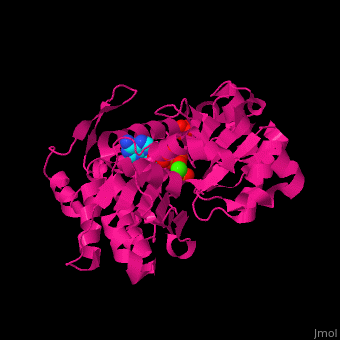Actin
FunctionActin is a protein found in all eukaryotic cells.[1] It is the monomer of two types of filaments: microfilaments which are part of the cytoskeleton and thin filaments which are part of muscles. Three isoforms of actin are identified: α (Aa) (or G-actin) found in muscle tissue, β (Ab) and γ (Ag) actins are components of the cytoskeleton. F-actin is Aa bound to ATP. For more details see: DiseaseMutations in α-actin found in skeletal striated muscles can cause myopathy. Mutations in α-actin found in smooth muscles can cause thoracic aortic aneurism. Mutations in α-actin found in heart muscles can cause heart malfunctioning. Structural highlightsin a cleft. Water molecules are shown as red spheres. . .[2] It changes its conformation upon hydrolysis of its bound ATP to ADP. Actin filaments are polar. They are formed with all monomers having their clefts pointing in the same direction. |
| ||||||||||
3D Structures of Actin3D Structures of Actin
Updated on 18-December-2018
ReferenceReference
- ↑ Otterbein LR, Graceffa P, Dominguez R. The crystal structure of uncomplexed actin in the ADP state. Science. 2001 Jul 27;293(5530):708-11. PMID:11474115 doi:10.1126/science.1059700
- ↑ Wang H, Robinson RC, Burtnick LD. The structure of native G-actin. Cytoskeleton (Hoboken). 2010 Jul;67(7):456-65. PMID:20540085 doi:10.1002/cm.20458
